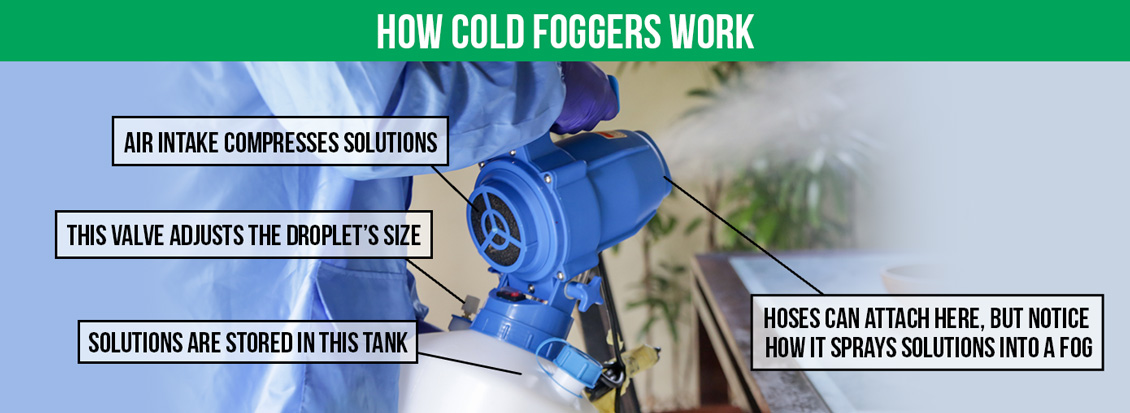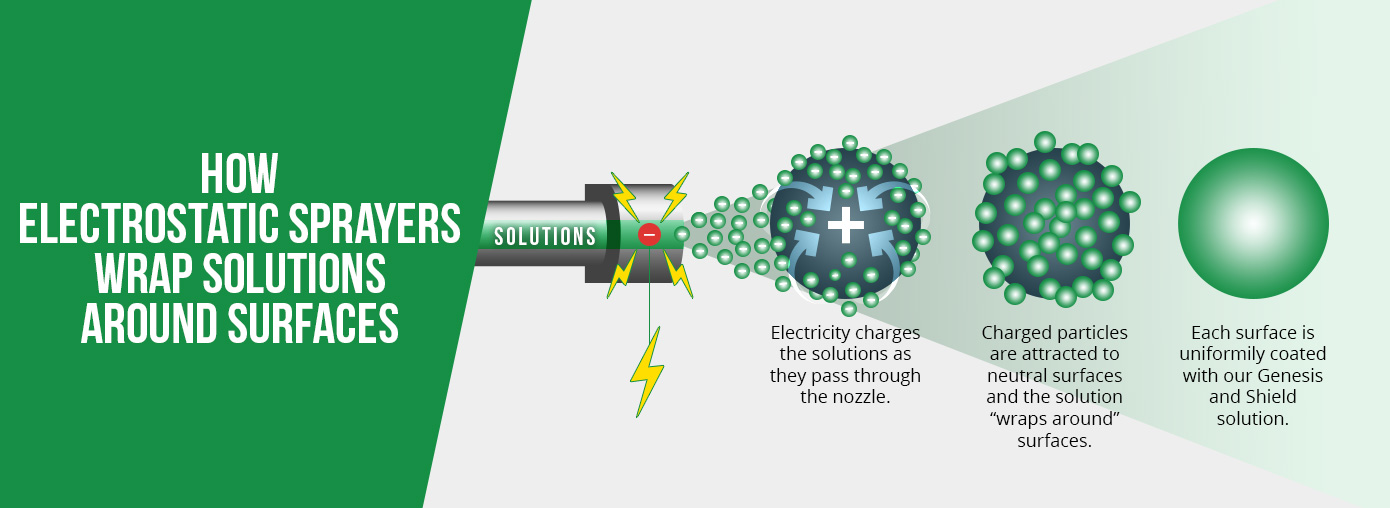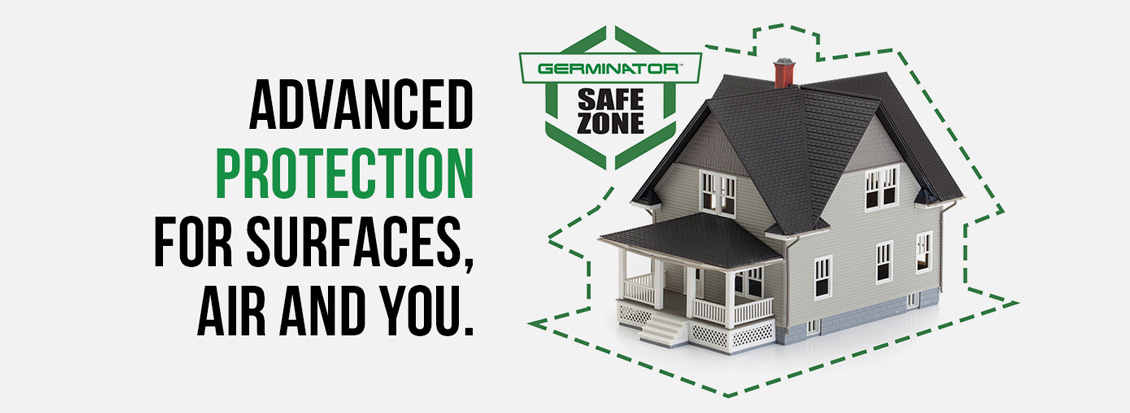Electrostatic Disinfection vs Fogging
March 15, 2021
Two Similar Devices with Very Different Outcomes
As soon as COVID hit, a race began to try to find a vaccine, but at the same time, there was an immediate rush of companies marketing their disinfectants and application equipment for treatment assistance. But within that rush came confusion on what tools actually work best for applying disinfectants.
By now, you've probably seen these backpack-wearing,
Ghostbuster-looking technicians spraying solutions to disinfect your favorite coffee shop, restaurant, local gym, and maybe even your favorite event space for you to hopefully soon catch a show, whenever indoor events are a thing again? The point is, you've probably seen these technicians using some kind of sprayer.
Well, when it comes down to efficiently spraying disinfectants, the devices these technicians use boils down to two types of sprayers.
The two most common devices in the field are backpack electrostatic sprayers (ES sprayers) and foggers or misters (that might look like leaf blowers). You're probably still wondering what the heck these devices do, but we'll get to that in a second. At least you know by now they spray disinfectants, but there's more to it than that.
Although each device is made to expel disinfectants out of the sprayer's nozzle, the outcomes are totally different. We'll be highlighting the differences between electrostatic disinfection vs fogging, and then we'll weigh the pros and cons of each device, so you'll know you're getting the most bang for your buck when choosing the right company.
Because you want a company that uses the best equipment in securing your business or home against the old and new world of germs for a protected tomorrow.
How ULV Cold Foggers or Misters Work
If you don't know what ULV means, it stands for "Ultra Low Volume," and it refers to the low level of pressure the solutions are being dispersed, so the devices use high volumes of air at a low pressure to transform disinfectants into a fine mist or fog.
The reason why they're set up this way is that the high compressed volumes of air will break the droplets down into extremely fine particles, but the low pressure slows the forward velocity; that way, disinfectants won't blow past or deflect off a targeted surface area.

When fogging, the size of the droplets can be small, at around two to five microns, give or take, and ULV cold foggers allow you to calibrate the flow, so you can increase or decrease the size of the droplets.
For disinfection, technicians will adjust their foggers to disperse larger droplets because they settle better on surfaces. If technicians were to mist, they'd adjust their nozzles even smaller than fogging, at around five to 25 microns, and like fogging, the purpose of misting is to keep the solutions suspended in the air so gravity can do its job and bring those solutions onto surfaces and objects.
How Electrostatic Sprayers Work
Remember that
Ghostbusters bit? Typically, that's what you see these days: a technician carrying around an electrostatic sprayer on his back (even though, yes, they do make backpack-styled cold foggers) because the popularity of ES sprayers has skyrocketed. They're everywhere, nowadays.
Fun fact, ES sprayers were patented in 1941 and used in the automotive industry for painting and in the agricultural industry for applying pesticides, so it makes sense why we use them to apply disinfectants.
So how does an electrostatic sprayer work?
ULV foggers need electricity, but they do not use it nearly the same way as an ES sprayer. With ES sprayers, electricity is literally part of the spraying process. These sprayers charge disinfectants with electricity as they pass through the sprayer nozzle.
The positively and negatively charged solutions are being repelled by one another as soon as they are dispersed. The solutions are actively seeking to attract to more neutrally charged surfaces and objects. This causes a wrap-around effect due to the electrical charges. A wrapping effect means less wasted spray, more coverage, and easier application.
Enough with the physics! Let's get into weighing the pros and cons of each sanitizing and disinfecting sprayer. The battle is on between electrostatic disinfection vs fogging.
Pros and Cons of Electrostatic Disinfection vs Fogging
Alright, you've made it this far and you want to know which method works best.
A technician can accomplish disinfection successfully with both devices, to be quite honest, but there are so many factors to account for, so you'll soon see why we prefer one over the other.
Ok, let's talk about the pros of using a ULV cold fogger.
The solutions stored in the tank of a fogger can be highly concentrated and won't affect the parts inside, which is both good for the technicians who use and maintain them and for you in the effectiveness of treating your spaces to treat germs.
Since technicians can adjust the valve, they can mist certain areas to suspend some of those solutions in the air while targeting and fogging surfaces directly for active disinfection.
Alright, simple enough, you now know that cold foggers can target surfaces with disinfectant, and since they utilize low volumes of pressure, they won't blow past or deflect off their intended target. However, it's time to let you in on the downsides, or cons, of ULV cold foggers.
The cons are that they rely on gravity and passively deliver droplets onto surfaces when misting or fogging areas depending on the sprayer's direction. It's also possible for the fog or mist to drift in an unintended direction.
When fogging surfaces, technicians tend to overdo it and completely soak an area with disinfectant making the drying time longer than it needs to be, and time is a contributing factor if you're on a tight schedule.
Also, foggers tend to provide uneven coverage resulting in one area being more disinfected than another. And it's usually because the calibration of the fogger can be finicky, so there's a technical element a technician must overcome when fine-tuning their devices.
So, what about electrostatic sprayers? What are the pros?
Technicians using ES sprayers coat surfaces and objects evenly with less wasted product. Since the solutions are electrically charged, they literally, and
we mean literally, wrap-around surfaces because of the physics involved with electricity.
Those electrostatically charged solutions are actively looking for a surface that contains the opposite charge. Simply put, a positively charged solution is looking for a negative electron, and we all know that opposites attract, right?

You can see in the picture above that the ES sprayers will provide 360-degree coverage around surfaces and objects with solutions, which is both cost-effective for the technician and you. It's less waste, honestly. ES sprayers disperse solutions in a controlled manner, so operationally speaking here, they provide far superior coverage. It takes less time to go from room-to-room and disinfect them and the solutions will dry faster.
So, what are the downsides? They can be quite pricey for technicians, especially for those airless models, but typically, a backpack ES sprayer will run in the low-end and be priced in the mid-hundreds and cap at the high-end around $5,000.
But for you, a downside of ES sprayers, a quality that misters or foggers will win in this round, is their inability to produce a small enough droplet size that can float in the air and disinfect it. Misters and foggers produce small droplet sizes that could technically disinfect suspended air particles temporarily.
But in all honestly, both devices weren't intended to disinfect the air; for air disinfection, it's recommended that you fit your home or business with an air purifier into your HVAC system for aerosol disinfection.
If you're looking for a proper method of disinfection, hands down, ES sprayers are the preferred device to use among sanitizing and disinfecting technicians. Second place would be ULV cold foggers because they do have their advantages, but nothing beats the superiority of an ES sprayer and its wrap-around effect.
And ES sprayers are what we use at Germinator to apply our Genesis HOCI (hypochlorous acid) solution and Shield solution when we're providing that advanced level of surface protection for your needs. But we take it a step further from the other guys who typically spray surfaces and go because we ATP test your surfaces using luminometers that can detect microbial activity. So before and after treating your spaces, we measure the levels of cleanliness on your surfaces.
Being able to test surfaces and gauge their level of cleanliness where germs may be present is a game-changer. Because after applying our one-two combo of EPA-registered solutions, you'll be able to reclaim the spaces you live, work, and have a good time in and just feel safe again.
That's a Wrap!
We provide advanced protection for surfaces, air and you, but we're also about educating you on the right way of choosing a sanitizing and disinfecting company. We've learned how electrostatic sprayers are superior to cold foggers or misters.
They provide that even coverage with their 360-degree wrap-around effect that cold foggers could never achieve. It's in the science and physics, and that's what makes ES sprayers overall better because of the electrical charge that the solutions carry while being dispersed as they attach to more neutral surfaces.
We're not trying to knock cold foggers in this post completely, we've used them before, but overall, we choose ES sprayers over cold foggers any day.

We believe that everyone has a right to better well-being and to feel safe in the spaces they live, work, and play. We want people to feel comfortable and, most importantly, protected—no matter where they are. It's the reason we got into this business because we don't just leave behind protected surfaces; we leave behind spaces that have been tested, sanitized, disinfected, and shielded to fight against the new world of germs.
So, if you're looking for advanced surface protection for your home or business, then fill out the form below and reclaim your space and just feel safe again with Germinator.
If you've found this article helpful, then make sure to head over and smash that like or follow button on our
Facebook, Instagram, or
Twitter profile.


